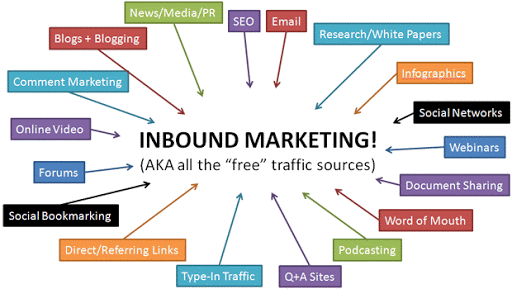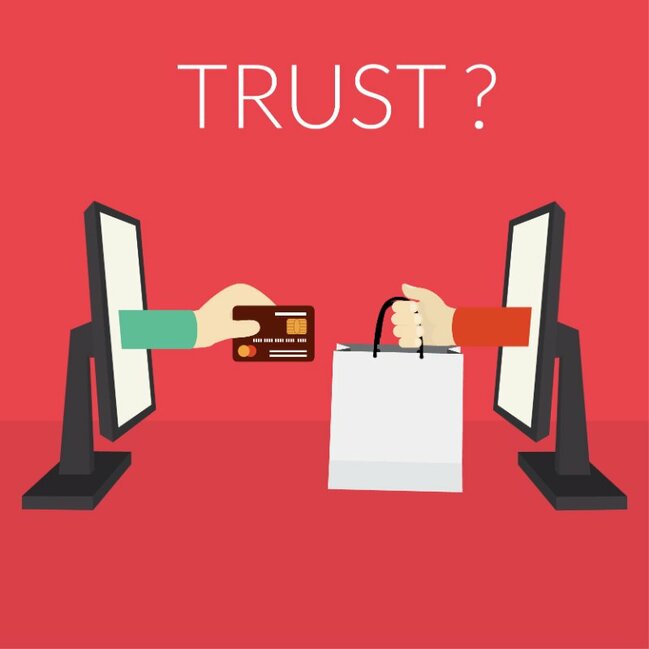Here are some of the ecommerce marketing mistakes your brand could be making (without even knowing it): #1 An Inefficient Website With Bad Mobile Optimization It’s more important than ever to ensure your website functions seamlessly. Otherwise, customers get distracted or frustrated and move on to the next thing. Having a beautifully designed, professional website that attracts and keeps customers is one of the best ecommerce marketing plans you can have. When it comes to mobile shopping, this sentiment goes double! Be sure your website has proper mobile optimization. The user experience of desktop and mobile shopping needs to be attractive, but also a well-oiled machine. From good SEO and product descriptions to excellent customer service, many of the ecommerce marketing mistakes listed below can help you achieve that. However, it starts with hiring the right website builders and integrating the right CMS platform for your business. #2 Forgetting Lead Capturing Potential customers might not always make an immediate purchase. That’s why it’s imperative to create a good lead capturing system. A pop-up for email signups (with a tempting discount) is one great way to turn those potential customers into first time buyers. You can also capture leads through chatbots and social media channels. Leadpages, ActiveCampaign and Getsitecontrol are just some of the powerful lead capturing and lead generation tools you have to work with. #3 Poor SEO and Product Descriptions It’s important to have an attractive website. This much is true. However, it’s also critical to have good SEO that draws customers to the website in the first place. An SEO plan using targeted keywords, accurate product descriptions, and well-written copy will help customers find your items with a simple search and give them the unique details of the item. You can hire someone internally to do so, but it’s more fruitful to hire an agency like Cennos that is already familiar with the proper use of long-tail keywords and in tune with more up-to-date trends and styles so your product descriptions are both search engine optimized, accurate, and appealing. #4 Ignoring Reviews and Testimonials With online shopping, having reviews and testimonials is more important than ever. Customers can’t touch and feel in person, so hearing or reading what previous buyers thought of the product is crucial. When building a website, be sure to make room for reviews and testimonials. Customers are more confident to purchase a product if they can read the social proof and what other customers think of it. It offers a level of transparency and boosts conversion rates. Having social proof on your website is just the first step. It can come in other ways too. Influencers can post their reviews across social media. Remember: It’s about more than a single product review. It’s also about your brand image. #5 Skipping on a Social Media Strategy Speaking of using influencers for social proof, let’s discuss the importance of a social media strategy. Promoting items and your brand online is a must in today’s age. If you aren’t taking advantage of social media platforms to engage with customers, you’re really missing a huge piece of the puzzle. However, it’s wise to come up with a social media strategy. For starters, it helps to know what social apps your target audience prefers. Then, you can create social media ads that show up in their algorithms. Again, this is where hiring a professional can help. Skilled social media strategists can ensure your ads are targeted correctly with the proper keywords, all while following each social platform's strict ad rules and regulations. #6 Not Focusing on Your Target Audience Another ecommerce marketing mistake that could be costing you? Not understanding your target audience. Or – and let’s say you do – simply not focusing on them. Driving traffic to your website through SEO and reviews helps, but it is also essential to hone in on your target audience directly. Sadly, many businesses cast a wider net with the intention of attracting a wider audience. But it pays to be as specific as possible! Research your target audience by creating a buyer persona so you can better understand what they are searching for in a product or service. Photo by Myriam Jessier on Unsplash
0 Comments
It’s an exciting time in the ecommerce world - and it’s only getting better. In just two short years – between 2019 and 2021 - online spending skyrocketed by 50.5%. Ecommerce sales now account for over 13 percent of total retail sales in the U.S., and this number is projected to grow to an impressive 22% by 2025. As online sales continue to surge, opportunities for ecommerce business owners are at an all-time high. But as more and more consumers turn to their laptops and smart phones to make purchases, more and more businesses are responding to the trend by taking their offerings online – which means more competition for you. In a crowded digital marketplace, traditional sales strategies like paid advertising and social media are no longer enough. These days, it’s all about creating value for customers with original content that educates, informs, or entertains.
Developing an ecommerce content marketing strategy may take time, but taking the time to get it right is well worth the effort. If you keep these ideas in mind as you create and promote your content, you’ll be on your way to building a loyal customer base and a powerful brand presence. From committing to a labor-intensive ecommerce biz, to choosing a product niche, to putting your ducks in a row and making sure you’re set to offer quality merchandise in a consistent fashion, there’s a big consideration that often stumps even the most prepared online sellers – and you must have it settled before day one of formal operations. What is your name? The art and science of choosing a business name can be an arduous process. And it’s deceptively, well, not easy. This is arguably the most important decision you’ll make as an ecommerce merchant. The considerations seem endless: first, once you pick one, you’re stuck with it. Second, it embodies your entire business, becoming a brand identity. If you’re fortunate enough, you could fall into an obvious win. The footwear retailer Shoebacca hit the jackpot with a moniker that’s clever, relevant, and just plain fun. Sales psychology is clear on the relationship between commerce and branding, so think carefully before you self-identify. Want some help? Asking friends and potential customers is always a plus. But so is consulting with experts – though that can be mind-numblingly expensive. There’s another option out there, and it’s a cool way to get started. Sites like Businessnamemaker will auto-generate suggestions based on keywords entered into their search window. There’s no telling whether it will come up with something fabulous, but it’s worth a try. NameSnack offers the same service, and surely there are several others. It features not only a search bar, but a list of possibilities. This cheeky site suggests a naming contest, possibly a great idea if you have access to a sufficient pool of participants who bridge the gap between niche obsession and creativity. Worthstart has already compiled a list of not-too-shabby business names, offering a headstart. Even if none pops out as a clear choice, merely reading the list may spark an idea of your own. Photo Credit: Rawf8/IStockPhoto.com It goes without saying that there are factors to consider when self-branding, and not the least of which is near-replication. If you inch too close to an existing business name, you risk a loss of sales due to confusion at best. At worst, you may receive a cease-and-desist letter from the entity with a similar name. Having to start from scratch carries a litany of problems.
Other considerations for selecting the perfect name include:
Nothing replaces quality merchandise and excellent service. Make that a priority. But your brand name, if it’s fitting and fun, will help you retain creative juices as you expand with marketing materials and tailored graphic imaging. Choose wisely, and you just might become a household name. It’s not every day you read a blog post that promotes other blog posts. In the growing sector of ecommerce, the novelty factor is still in play, and merchants can use all the help they can get. Trading ideas may be a boon for both parties, as small fish rely on big fish, and big fish discover trending new product lines, marketing strategies, and fresh ideas from the relative minnows.
Some of the best and most useful ecommerce-related blogs both sharpen the focus of online selling and invite an expansion of old ideas. They recount what works and what’s been more duplicitous or unwieldy. They draw readers out of a place of isolation faced by many who move from in-person operations to digital selling. Here are some of our favorite blogs that explore comprehensive facets of online merchandising, in no particular order: Ecommerce Nation Blog Geared to a global audience, this site delivers news, tips, interviews with industry movers and shakers, and an assortment of creative topics. Nosto Blog Greeted by a sweet little basenji, your first experience with Nosto’s current post goes beyond the dog-eat-dog world and ferrets out the reimbursement element of commerce. Though nearly a year old, its most interesting entry addresses multi-currency as a solution to cross-border selling. Finance-related concerns rarely age, and on Nosto you’ll find a menu of useful topics laid out in a nice interface. EcommerceFuel Blog True to its name, ECF dazzles with an array of news and information relevant to both small and big businesses. From advice on customer loyalty programs to personal wellness for the ecommerce merchant, and from unconventional email campaign strategies to cathartic humor, this site makes it fun to devote your energy to online selling. BigCommerce Blog Don’t be fooled by a title – Big Commerce is just as useful for the little guy. With a bevy of tips from veteran online merchants, this blog offers incentives for experimenting with both proprietary and unconventional ways to conduct business from start to finish. Its clean layout is easy to navigate; its content is inspiring enough to peruse for extended periods of time. Many like sites add tips on the best ecommerce business ideas, but BigCommerce follows through with numerous examples sourced from outside their domain. Volusion Blog Volusion’s blog, “The Ecommerce Authority,” is a veritable treasure chest of information and tips. With Black Friday around the corner, its multiple posts related to holiday sales makes it a worthy read. Add pieces on personal merchant stories, web page optimization, rating payment platforms, and running SEO tests, and you have a blog source you will want to bookmark. Last week we introduced the topic of inbound marketing, a new approach to integrating the lifestyle aspect of potential and existing customers with meaningful content that can lead to a longstanding commercial relationship. For ecommerce merchants, inbound marketing holds enormous promise.
But it’s not as simple as its reverse strategy of outbound marketing. Sending emails, buying pop-up ads, and initiating contact at your chosen pace is waning as an effective way to win customers. Learning to work your marketing into the increasing online engagement of buyers takes patience, insight, a bit of technical know-how, and a sincere desire to improve the lives and livelihoods of everyone. For newer sellers who may feel out of their league, here are some tips on how to make inbound marketing work for you. Confused as you may be by the litany of jingo surrounding Everything Internet, there’s a term you will want to embrace: Inbound Marketing.
The “inbound” modifier sets forth an important distinction between the conventional idea of marketing employed by businesses for decades. It refers to a trending 21st Century concept of capturing both the lifestyle factor and the online engagement of customers and potential customers. “Outbound marketing” involves pop-up ads, direct-sales emailing, and anything produced as a proactive attempt to sell your brand or product. With the proliferation of information made possible by online commerce, and the evolving comfort level of humans warming up to an increasing amount of time spent online, marketing strategies in current times demand more creative adaptations. Inbound marketing seeks to make your brand part of a consumer’s life, avoiding the tendency to disrupt their focus with unsolicited communications. Analysts call this “interruptive marketing,” citing dismal results as consumers already inundated with an overflow of stimuli are more inclined to seek out their own personalized content that will lead to buying decisions. The advent of mass interruptive advertising and marketing has led to a greater demand for technology that blocks such content, and that demand has been mostly fulfilled. Currently about one-quarter of web crawling prospective clients employ ad-blocking software. This is a disaster for any business still clinging to proactive, interruptive advertising. Worse, the traditional display ad on digital media shows a click-through rate of less than 1 percent among those who do not block ads. Driving sales for underperforming products and services can be a tough task. These products and/or services need additional tactics to help it perform and this is where scarcity marketing. This technique helps move sales for these items based on their rarity. With things so readily available to consumers through online shopping, more and more consumers find value in things that feel more exclusive. So here are several useful tactics for scarcity marketing for your small online business.
Establish Product Availability It is important to let your consumers know how many items are still available for purchase. The point of this tactic is to establish a sense of urgency to influence consumers to purchase this product or service as soon as possible. If there are only three items left in stock, set an alert on your webpage to let customers know. Limited Edition & Seasonal Products Another way to establish a sense of urgency for products is to create special collections. These are products with limited quantity and will not be replenish them once they are sold out. This makes the product feel rare and exclusive which entices potential customers. Seasonal collections are also effective that may only come out during a certain time of year. Pre-Sale Offers Creating a pre-sale offer for exclusive products brings a sense of excitement for potential customers. It can also gauge the demand for your product and bring in sales before the launch. This is also an effective way to show other consumers the high demand for your business as well. Out-of-Stock Alerts & Low Stock Notices When your items are out of stock, let your customers set alerts to know when an item is available again. Also let your consumers know when you are products are low in stock so they are more enticed to make a purchase before the item becomes sold out. This keeps a relationship between the consumer to come back for either the same item or perhaps another. Exclusive Discounts Customers love discounts and they love exclusive ones even more. You can do this by rewarding loyal customers as a follow-up from a purchase, signing up for your newsletter, and following your business on social media. Flash sales are also a good tactic to use as an exclusive short-term sale to attract attention to products as well. If you have a physical storefront, you can hand out invites to in-store patrons who make a purchase. As brick-and-mortar stores continue to collapse into bankruptcy, leaving blighted, empty buildings, there is a lesson to be learned from each.
Their customers trusted them. Big-time retailers Kmart and Sears, now jointly owned, still has loyal fans who are eagerly following the roller coaster ride of their dismal-yet-uncertain fate. If you are an ecommerce vendor, it’s imperative that you study and reflect on the way these conventional stores captured trust and converted it into continuing revenues. Mirroring their marketing tactics, which usually include special sales, coupons, and notable customer service policies, can set you up to become an internet fave – if you play your cards right. In the ecommerce universe, that means generating “micro-conversions,” or turning initial signs of interest into an established consumer relationship. Focus first on these obvious, easily implemented strategies: If you’ve been a copywriter for any length of time, you know the ongoing debate of what the ideal length of a sales letter should be. As long-time A-list copywriter Mark Ford notes, everyone purports to despise long copy, yet it has always consistently out-pulled and outsold short copy.
But what about social media posts? Is shorter copy is the ticket to higher sales? Some say that copywriting has evolved—and social media is to thank (or blame) for it. But saying it has evolved is too broad a brush to paint this picture. It’s more accurate to say that copywriting has expanded. Different media platforms may take center stage now, yet the same principles upon which advertising and marketing were built in the mid-20th century still apply. So, in today’s social media-dominated world, how much is too much? Is it possible to optimize the length of a post to engage and convert readers? What’s the ideal length of a post to drive viral engagement that reaches as many people as possible? As always, it’s up to you to find out what your unique audience wants and cares about. To know their pains and concerns so you can offer the best solution, service, or product for them. Generally speaking, though, it depends on your forum. But to know for sure, you’re going to have to test and find out what works for you. Neither guessing nor being creative for the sake of it is going to cut it. Remember when writing was somewhat pedestrian and simple? When presenting compelling and provocative prose to draw audience attention was solely a factor of how you string sentences together? You can suspend that, at least partly. Key in a migration of communications from print to digital is the necessary intrusion of technology, which means wording sentences and ideas in a way that they are captured and rechurned through algorithms on search engines.
But it’s possible that the race to tap into somewhat robotic Search Engine Optimization (SEO) may be a bit premature. There are still arguments to be made for focusing on the human target as opposed to a reliance on converting your input to a system that delivers ordered results. By now you’re envisioning your 9th grade composition teacher’s pleas to embrace a conversational voice. Turns out there’s still a solid argument for that, because the predominant search entity, Google, still evaluates text for its readability and adherence to rules of approachable writing. Here’s a rather protracted guide of how Google attempts to legitimize and rank search criteria. High on Google’s list is a reputation-based evaluation. How trustworthy is the source? How much expertise does the writer have? Low-quality submissions that are not verifiable will be ranked lower. And make no mistake about it: Google employs human beings to assess these things. |
Archives
October 2021
Categories
All
|












